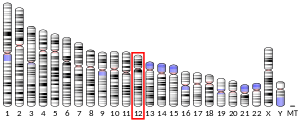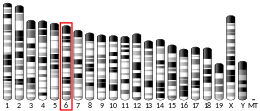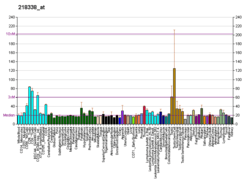PHC1
Polyhomeotic-like protein 1 is a protein that in humans is encoded by the PHC1 gene.[5][6]
Function
This gene is a homolog of the Drosophila polyhomeotic gene, which is a member of the Polycomb group of genes. The gene product is a component of a multimeric protein complex that contains EDR2 and the vertebrate Polycomb protein BMI1. The gene product, the EDR2 protein, and the Drosophila polyhomeotic protein share two highly conserved domains, named homology domains I and II. These domains are involved in protein–protein interactions and may mediate heterodimerization of the protein encoded by this gene and the EDR2 protein.[6]
Mutations in this gene have been associated to cases of primary microcephaly.[7]
Interactions
PHC1 has been shown to interact with BMI1[5][8] and PHC2.[5][9]
References
- GRCh38: Ensembl release 89: ENSG00000111752 - Ensembl, May 2017
- GRCm38: Ensembl release 89: ENSMUSG00000040669 - Ensembl, May 2017
- "Human PubMed Reference:". National Center for Biotechnology Information, U.S. National Library of Medicine.
- "Mouse PubMed Reference:". National Center for Biotechnology Information, U.S. National Library of Medicine.
- Gunster MJ, Satijn DP, Hamer KM, den Blaauwen JL, de Bruijn D, Alkema MJ, van Lohuizen M, van Driel R, Otte AP (Apr 1997). "Identification and characterization of interactions between the vertebrate polycomb-group protein BMI1 and human homologs of polyhomeotic". Molecular and Cellular Biology. 17 (4): 2326–35. doi:10.1128/mcb.17.4.2326. PMC 232081. PMID 9121482.
- "Entrez Gene: PHC1 polyhomeotic homolog 1 (Drosophila)".
- Awad, Salma; Al-Dosari, Mohammed S; Al-Yacoub, Nadya; Colak, Dilek; Salih, Mustafa A; Alkuraya, Fowzan S; Poizat, Coralie (2013-06-01). "Mutation in PHC1 implicates chromatin remodeling in primary microcephaly pathogenesis". Human Molecular Genetics. 22 (11): 2200–2213. doi:10.1093/hmg/ddt072. ISSN 1460-2083. PMID 23418308.
- Satijn DP, Gunster MJ, van der Vlag J, Hamer KM, Schul W, Alkema MJ, Saurin AJ, Freemont PS, van Driel R, Otte AP (Jul 1997). "RING1 is associated with the polycomb group protein complex and acts as a transcriptional repressor". Molecular and Cellular Biology. 17 (7): 4105–13. doi:10.1128/mcb.17.7.4105. PMC 232264. PMID 9199346.
- Rual JF, Venkatesan K, Hao T, Hirozane-Kishikawa T, Dricot A, Li N, Berriz GF, Gibbons FD, Dreze M, Ayivi-Guedehoussou N, Klitgord N, Simon C, Boxem M, Milstein S, Rosenberg J, Goldberg DS, Zhang LV, Wong SL, Franklin G, Li S, Albala JS, Lim J, Fraughton C, Llamosas E, Cevik S, Bex C, Lamesch P, Sikorski RS, Vandenhaute J, Zoghbi HY, Smolyar A, Bosak S, Sequerra R, Doucette-Stamm L, Cusick ME, Hill DE, Roth FP, Vidal M (Oct 2005). "Towards a proteome-scale map of the human protein-protein interaction network". Nature. 437 (7062): 1173–8. doi:10.1038/nature04209. PMID 16189514.
Further reading
- Alkema MJ, Bronk M, Verhoeven E, Otte A, van 't Veer LJ, Berns A, van Lohuizen M (Jan 1997). "Identification of Bmi1-interacting proteins as constituents of a multimeric mammalian polycomb complex". Genes & Development. 11 (2): 226–40. doi:10.1101/gad.11.2.226. PMID 9009205.
- Satijn DP, Gunster MJ, van der Vlag J, Hamer KM, Schul W, Alkema MJ, Saurin AJ, Freemont PS, van Driel R, Otte AP (Jul 1997). "RING1 is associated with the polycomb group protein complex and acts as a transcriptional repressor". Molecular and Cellular Biology. 17 (7): 4105–13. doi:10.1128/mcb.17.7.4105. PMC 232264. PMID 9199346.
- Tomotsune D, Takihara Y, Berger J, Duhl D, Joo S, Kyba M, Shirai M, Ohta H, Matsuda Y, Honda BM, Simon J, Shimada K, Brock HW, Randazzo F (Dec 1999). "A novel member of murine Polycomb-group proteins, Sex comb on midleg homolog protein, is highly conserved, and interacts with RAE28/mph1 in vitro". Differentiation; Research in Biological Diversity. 65 (4): 229–39. doi:10.1046/j.1432-0436.1999.6540229.x. PMID 10653359.
- Ohta H, Tokimasa S, Zou Z, Funaki S, Kurahashi H, Takahashi Y, Kimura M, Matsuoka R, Horie M, Hara J, Shimada K, Takihara Y (2000). "Structure and chromosomal localization of the RAE28/HPH1 gene, a human homologue of the polyhomeotic gene". DNA Sequence. 11 (1–2): 61–73. doi:10.3109/10425170009033970. PMID 10902910.
- Levine SS, Weiss A, Erdjument-Bromage H, Shao Z, Tempst P, Kingston RE (Sep 2002). "The core of the polycomb repressive complex is compositionally and functionally conserved in flies and humans". Molecular and Cellular Biology. 22 (17): 6070–8. doi:10.1128/MCB.22.17.6070-6078.2002. PMC 134016. PMID 12167701.
- Suzuki M, Mizutani-Koseki Y, Fujimura Y, Miyagishima H, Kaneko T, Takada Y, Akasaka T, Tanzawa H, Takihara Y, Nakano M, Masumoto H, Vidal M, Isono K, Koseki H (Sep 2002). "Involvement of the Polycomb-group gene Ring1B in the specification of the anterior-posterior axis in mice". Development. 129 (18): 4171–83. PMID 12183370.
- Luo L, Yang X, Takihara Y, Knoetgen H, Kessel M (Feb 2004). "The cell-cycle regulator geminin inhibits Hox function through direct and polycomb-mediated interactions" (PDF). Nature. 427 (6976): 749–53. doi:10.1038/nature02305. PMID 14973489.
- Brandenberger R, Wei H, Zhang S, Lei S, Murage J, Fisk GJ, Li Y, Xu C, Fang R, Guegler K, Rao MS, Mandalam R, Lebkowski J, Stanton LW (Jun 2004). "Transcriptome characterization elucidates signaling networks that control human ES cell growth and differentiation". Nature Biotechnology. 22 (6): 707–16. doi:10.1038/nbt971. PMID 15146197.
- Wang H, Wang L, Erdjument-Bromage H, Vidal M, Tempst P, Jones RS, Zhang Y (Oct 2004). "Role of histone H2A ubiquitination in Polycomb silencing". Nature. 431 (7010): 873–8. doi:10.1038/nature02985. PMID 15386022.
- Voncken JW, Niessen H, Neufeld B, Rennefahrt U, Dahlmans V, Kubben N, Holzer B, Ludwig S, Rapp UR (Feb 2005). "MAPKAP kinase 3pK phosphorylates and regulates chromatin association of the polycomb group protein Bmi1". The Journal of Biological Chemistry. 280 (7): 5178–87. doi:10.1074/jbc.M407155200. PMID 15563468.




